
By MADELEINE O'NEILL | moneill@baltsun.com
Legal obstacles are now cleared to allow some crew members of the cargo ship that destroyed the Francis Scott Key Bridge to return home after 12 weeks stuck aboard the vessel.
A court hearing Thursday morning confirmed that the army of lawyers involved in litigation surrounding the crash reached an agreement late Wednesday that will permit some members of the crew to leave the United States and be deposed at a later date.
The hearing was scheduled originally in response to emergency motions from the city of Baltimore and another party, both of which have claims against the cargo ship Dali and raised concerns after learning this week that crew members could be leaving the country as soon as Thursday.
The ship’s operator is bringing on a replacement crew, which occurs periodically with crews in the industry, before the Dali is moved to Norfolk, Virginia, for more repairs as early as next week.
Both parties ultimately withdrew their motions and indicated they were able to reach an agreement: The lawyers for the ship’s owner and manager will guarantee that the crew members will appear for depositions later, possibly in London.
In all, eight crew members and two trainee cadets have been granted permission to return to their home countries, said Darrell Wilson, a spokesman for Synergy Marine Group, the vessel operator. The group includes a cook, several seamen, a fitter, an oiler and a general steward.
Thursday’s hearing included seven government lawyers from various agencies, including the U.S. Department of Justice and the National Transportation Safety Board. None spoke at the hearing, where Senior U.S. District Judge James K. Bredar reaffirmed that an agreement had been reached and asked the lawyers to be as efficient as possible in the future.
Thursday’s hearing could have been avoided entirely if the lawyers for one of the claimants had withdrawn their emergency motion Wednesday night instead of Thursday morning, said Bredar, addressing attorneys William H. “Billy” Murphy Jr. and Jason P. Foster.
“How are we going to conduct this very complex and potentially lengthy proceeding in the coming months and years?” Bredar asked. “My aspiration is that we’re going to do so efficiently and with every lawyer bringing their A-game and being conscious of the fact that the actions they take or don’t take have consequences.”
After the hearing, Murphy said he was satisfied the emergency was resolved.
“We’re happy that we were able to file the emergency motion and cause the agreement to be made,” Murphy said.
His team filed the withdrawal as quickly as they could, he said, adding that they were still in negotiations as late as this morning.
Murphy’s client in the litigation, Damon A. Davis, has not yet filed his claim against the Dali. Murphy declined to describe his client’s connection to the case Thursday, saying Davis is suffering from post-traumatic stress disorder and does not want publicity.
RELATED ARTICLES
Maryland board to consider $50M contract with Skanska for Key Bridge cleanup
A dance on the water: Baltimore’s 6 harbor-assist tugboats essential to the port
Cargo ship Dali readying for trip to Virginia, will be assisted by 6 vessels
12 weeks after Key Bridge collapse, Dali crew still on board. Now a deal means some could be leaving.
The legal dispute began Tuesday when an attorney for the ship’s owner and manager, William Bennett, emailed claimants and informed them that eight crew members would be allowed to leave as early as Thursday.
The Coast Guard declined a request to help secure crew members temporary parole through Customs and Border Patrol, Bennett wrote, so the men would need to go directly to the airport from the vessel.
Claimants’ attorneys objected, noting that they had been promised plenty of notice before crew members began to return home. Their emergency motions triggered Thursday’s hearing, though the deal was reached before Bredar could take the bench.
The final agreement included the two trainees, whose names were not on the original list of crew members granted permission to leave. The ship’s lawyers also agreed to turn over personnel files and other documents about the crew members.
The Dali struck the Key Bridge early on the morning of March 26, collapsing the span into the Patapsco River and killing six members of a crew who were doing road work on the bridge. The accident closed the Port of Baltimore to all vessel traffic for weeks. It wasn’t fully reopened until this month.
The ship’s owner and manager, both companies based in Singapore, quickly filed a limitation of liability action in federal court aimed at capping the amount of damages they could be forced to pay at about $43 million, roughly the salvage value of the Dali and its cargo. Parties who believe they may be entitled to damages stemming from the crash have until September to file claims against the ship.
The Dali remained pinned under the Key Bridge until last month, when it was refloated and moved to Seagirt Marine Terminal. The massive ship and its crew, who are from India and Sri Lanka, have remained there since, as workers removed more bridge debris from the ship’s bow.
By Bernd Debusmann Jr, BBC News, Washington
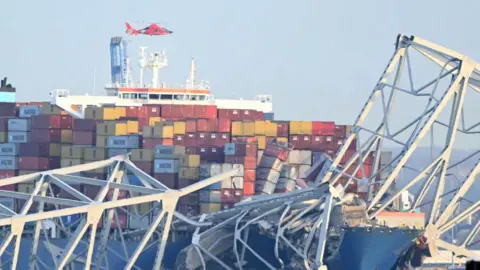
Some crew members on the cargo ship that struck a major bridge in Baltimore are set to return home after nearly three months on the vessel, according to the cargo ship's management company.
Earlier this week, Baltimore officials dropped a petition that would have prevented the crew members from leaving so that they could be questioned.
The 21 seafarers, predominantly from India, have been stranded on the MV Dali since it crashed into Baltimore's iconic Francis Scott Key bridge on 26 March, causing it to collapse.
Six construction workers who were on the bridge were killed in the incident, which remains the focus of two investigations from the FBI and National Transportation Safety Board (NTSB).
The crash sent the mile-long bridge, a regional transportation artery, into Maryland's Patapsco River and across the vessel's deck, blocking the port of Baltimore.
The seafarers have lived on the vessel since the crash occurred. They were unable to depart the ship because they were considered witnesses and did not have valid visas or shore passes to enter the US.
According to local media reports, a deal reached between the city of Baltimore, the ship's owners, and its management company will now allow some sailors to leave the vessel.
But they will have to be made available for depositions even after they leave the US.
The number of crew members initially headed home - and their date of departure - is unclear.
When contacted by the BBC, Synergy Marine - the ship's management company -spokesperson Darrel Wilson said that the company is "working to send some crew home", while "some will remain to assist with the investigation".
He added that the crew is "doing well".
Andrew Middleton, who runs Apostleship of Sea - a programme that ministers to ships coming through Baltimore - said there were "mixed emotions" on board the ship when he went to meet the sailors on Thursday.
"The ones that get to go home are happy, relieved," he said. "But the ones that are staying are wondering when they will get to go home too. That's added to the mental strain."
He added that he believes some crew members may leave within days.
Mr Middleton said that it remains unclear when the remaining sailors will be given shore passes to step off the vessel, or what that will "look like" when they are.
Some, he said, could ultimately be housed in hotels while the investigations progress, an experience he said could be "isolating" without their fellow crew members.
Two unions representing the sailors said in May that morale on the ship had "dipped" due to "unfounded fear of personal criminal liability" and emotional distress.
Grace Ocean Private Ltd, which owns the ship, did not immediately respond to a request for comment.
In court documents filed earlier this week, lawyers for Baltimore said they were made aware last-minute that eight of the seafarers were planning to leave the country as early as Wednesday.
Mr Middleton also said he believes that eight sailors are expected to leave.
The city initially called for a judge to intervene to prevent that from happening.
A deal reached late Wednesday, however, includes a guarantee that the "vessel interests will produce the witness in question for deposition during the discovery phase" of legal proceedings, court documents show.
Baltimore officials are currently working to determine potential compensation for the incident and have resisted attempts by the Dali's owner to cap damages at $43m (£33.9m).
The US Justice Department has already interviewed the Dali's crew as part of its own investigation and has no objection to them leaving the country.
After months stranded under the metal and steel remnants of the Key Bridge, the 948ft (289m) ship was towed away last month and is now at a local container terminal.
Replacement sailors will be brought in while the ship remains at the terminal, according to CBS, the BBC's news partner.
Last week, the shipping channel outside of Baltimore that had been blocked by the crash was re-opened after 11 weeks of closure.
Deal Reached for First Dali Crewmembers to Depart
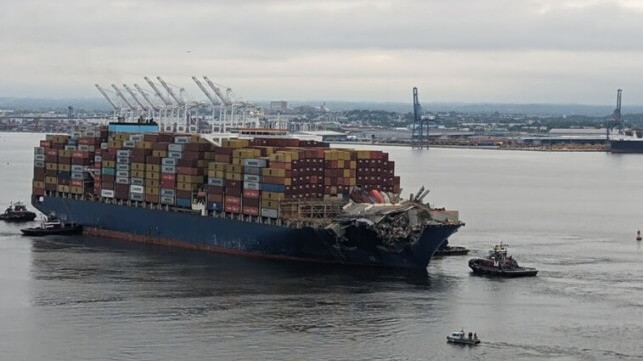
A deal was reached between the lawyers representing the City of Baltimore and the other claimants in the lawsuits with the owners and operators of the Dali that will permit the first of the crewmembers to depart the ship some 12 weeks after the vessel hit the Baltimore bridge. At the same time, the U.S. Coast Guard is reporting that the containership might also be departing Baltimore as early as tomorrow, Friday, June 21 with a replacement crew aboard.
The U.S. District Court met on Thursday for an emergency pretrial conference and the Judge James Bredar signed off on the deal that had been reached for the crew. The order filed today clears the way for three Able Body seaman, an ordinary seaman, an oiler, a fitter, a cook, and a general steward, to leave the vessel at the end of their contract and travel as early as today to their homes. Late on Thursday, the International Seafarers Center said travel has been arranged for Friday evening for the eight people.
The lawyers had initially sought to block the efforts to begin supplying a replacement crew to the vessel arguing that they had only been given two day’s notice despite earlier promises from Grace Ocean and Synergy Marine. They told the court that the departure could prevent “crucial discovery,” for the individuals who might not be available once they left the country.
All the lawyers met and conferred with the lawyers for Grace Ocean and Synergy and later filed a motion to withdraw their request. In exchange, Grace Ocean and Synergy Marine agreed to substantively respond to written discovery and guarantee the appearance of the eight crewmembers when the case reaches the deposition stage. The crewmembers leaving the ship are agreeing to appear in London or elsewhere to provide depositions which are not expected to happen sooner than November 2024.
The eight crewmembers of the approximately 21 aboard the vessel will be replaced by Synergy Marine. So far, there has been no mention of the timing when other crewmembers might be permitted to travel to their homes in India and Sri Lanka. The Seafarers Center said the crew will be moving to hotels onshore in Baltimore as they are being required to remain at the time as the legal cases proceed. The government will provide apartments or hotel rooms for the duration of the litigation.
The Dali after spending 55 days trapped under the wreckage of the Francis Scott Bridge has now been at Baltimore’s Seagrit Terminal for 31 days. During that time, additional debris was removed including more of the damaged containers from the bow. The Baltimore Sun is reporting that the work was completed yesterday and that there is no longer any overhanging debris and the U.S. Coast Guard believes all the loose debris has been removed or secured.
Coast Guard Cmdr. Baxter Smoak told The Baltimore Sun that the vessel could depart as early as Friday in what will be a “highly choreographed” operation to get the vessel from Baltimore to Norfolk, Virginia for the next phase of the recovery and repairs. Earlier reports had said the vessel would be offloaded and initial repairs made to the bow so that the owners could move the containership to another shipyard.
Describing the operation to The Baltimore Sun, the Coast Guard explained one challenge is that the Dali no longer has anchors. The one that was dropped on March 26 in an effort to slow the ship was cut off during the first phase of the salvage operation. The other anchor was “completely crushed” the newspaper says in the allision with the bridge. The ship will be underway with some of the debris still on its bow and it must go the USCG says from terminal to terminal not holding offshore to wait for a space. Late on Thursday, the International Seafarers Center said the departure is tentative set for 1800 on Friday.
While the Dali will be moving under its power for the voyage which is estimated to take 16 to 20 hours, the vessel will be accompanied by a small flotilla for safety. The USCG told The Baltimore Sun there will be four tugs accompaning led by a U.S. Coast Guard cutter. Resolve Marine will also supply an escort with the USCG saying one goal was to monitor to confirm nothing falls from the vessel. If it does the escorts will make it possible to immediately mark the debris for recovery.
Lawyers Ask Court to Block Departre from US of First Eight Crew from Dali
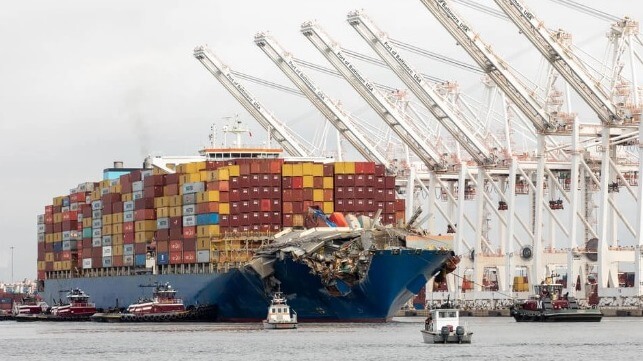
The crew of the containership Dali which knocked down the Francis Scott Key Bridge in Baltimore remains at the center of the brewing legal battles 85 days after the ship hit the bridge. So far none of the approximately 22 crewmembers have been permitted to leave Baltimore and now lawyers for the plaintiffs including the City of Baltimore are asking the U.S. District Court to block the departure of the first crewmembers as part of an effort by the vessel’s operator to arrange for a replacement crew.
The Dali remains in Baltimore at the Seagirt terminal where she was moved after the bridge debris was removed last month. Work is ongoing on the salvage of the vessel removing more containers and debris, but the crew remains aboard nearly three months after the allision with the bridge.
Lawyers for the vessel’s operator, Synergy Marine and owners Grace Ocean informed the plaintiffs in an email on June 18 that eight of the crewmembers were scheduled to leave the vessel for return to their homes in India and Sri Lanka. The list consists of eight individuals, including three ABs, one ordinary seaman, an oiler, a fitter, a cook, and a general steward.
The plaintiffs are objecting citing an email from April that said they would be given notice and there would be provisions for interviews or depositions before any crewmembers left the ship. In the court filing, they argue that if these individuals are permitted to leave “claimants may never have the opportunity to question or depose them.”
The crewing company says these individuals' time is up and they are arranging for replacement crewmembers for the vessel. Further, they reported they inquired with the U.S. Coast Guard to waive CBP (Customs and Border Protection) restrictions to permit the crew to remain temporarily in the U.S. and it was refused. All the crewmembers have already been interviewed by the Department of Justice, the notice states, and there is no objection to their departure from the United States. The plan was to transfer the crew possibly as early as tomorrow, June 20, from the ship directly to the airport.
The plaintiffs asked for an emergency hearing now scheduled for June 20, and the judge ordered Grace Ocean and Synergy Marine “not to facilitate” the departure of any crewmembers. The court also instructed the United States not to deport the crewmembers before the hearing.
The court notes it is unclear if it can retain the crewmembers while also saying that there was no time for the opposing parties to be heard and seek relief. They also note the plaintiff’s lawyers cited minimal authority that supports the request.
In the past in lesser cases such as MARPOL violations, the U.S. has ordered crewmembers to remain in the United States to provide testimony. These waits can stretch into months or even a year or more despite objections from lawyers for the crewmembers. In this case, the lawyers for the crewmembers said they will advise the individuals to invoke the Fifth Amendment of the U.S. Constitution which provides the protections against self-incrimination (i.e. the right to remain silent).
Seamen's Church: Dali Disaster Highlights Crew Welfare Lesson Learned
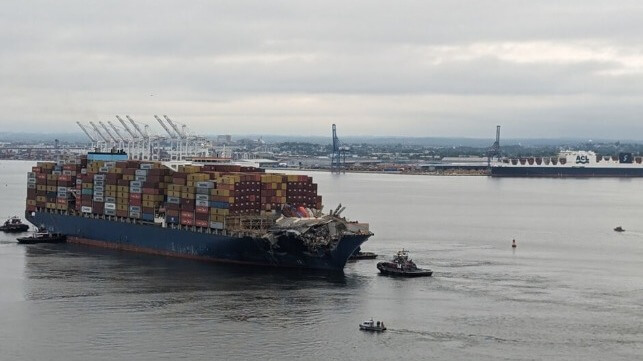
The tragic allision of the Dali container ship with the Francis Scott Key Bridge in Baltimore highlights the often-overlooked humanitarian impact of maritime incidents and the mental pressures faced by seafarers. The first seafarer charity on the scene, the Seamen’s Church Institute (SCI), is advocating for increased support for affected crew members. The SCI team found a traumatized crew aboard the Dali and is urging leaders in maritime and regulatory bodies to consider the human impact when undertaking a presumably lengthy but necessary investigation.
The Rev. Mark Nestlehutt, president and executive director of SCI, emphasizes the importance of making swift decisions regarding the 21 crew members, including their return home and potential legal consequences.
“While the logistics of wreckage removal and ship movement are crucial, we must also prioritize the crew who have endured significant trauma since the accident,” he says. The crew have been deeply affected by the loss of six construction workers and deserve a measure of empathy and support.
“Imagining ourselves in their position helps us understand their constraints and the pressure they are under," he adds.
The 21 seafarers - 20 Indians and one Sri Lankan - are being well cared for by Synergy Marine, the vessel's management company. But despite receiving support they have been confined to the ship since March 26, unable to take any break away from the scene.
“The uncertainty they face about seeing their families again and the looming investigation are major stressors,” explains Mr. Nestlehutt. “With the final report potentially taking two years, consideration and clarity on their situation is important.”
Mr. Nestlehutt suggests that U.S. authorities, including the US Coast Guard, FBI, and National Transportation Safety Board, consider expediting decisions regarding the crew’s status, perhaps determining which crew members are essential to the investigation and allowing others to return home. "With some of their contracts ending over a month ago, these seafarers are now looking at extended stays on the vessel, and that can cause distress and impact mental health," he says.
The COVID-19 pandemic underscored the detrimental effects of prolonged and extended vessel confinement on seafarers' mental health. Consequently, renewal of the crew’s visas and permitting non-essential members to take shore leave would offer much-needed relief. Currently, expired visas prevent them from stepping ashore in Baltimore, which exacerbates their predicament.
After the March 26 collision, SCI's proactive response included the deployment of chaplains trained in Critical Incident Stress Management within a week of the accident. Additionally, in the following weeks, SCI provided chaplain associates who speak Hindi and Tamil, ensuring that the crew received culturally and linguistically appropriate support.
The Dali disaster can be considered a call to action for the maritime industry and regulatory bodies to enhance their response protocols for seafarers in distress. By prioritizing their well-being and expediting necessary decisions, we can demonstrate our commitment to those who keep global trade moving, even in the face of adversity.
The opinions expressed herein are the author's and not necessarily those of The Maritime Executive.




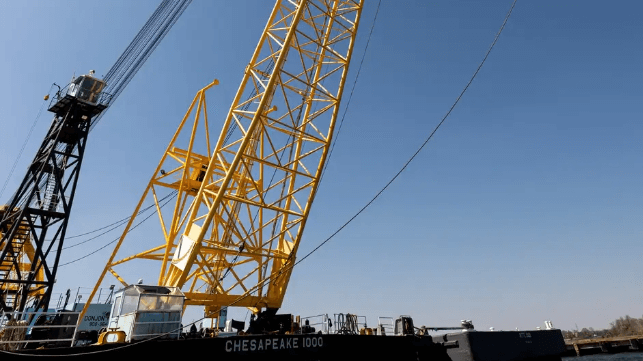
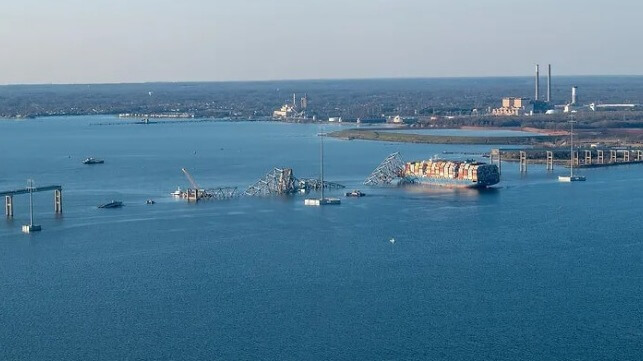
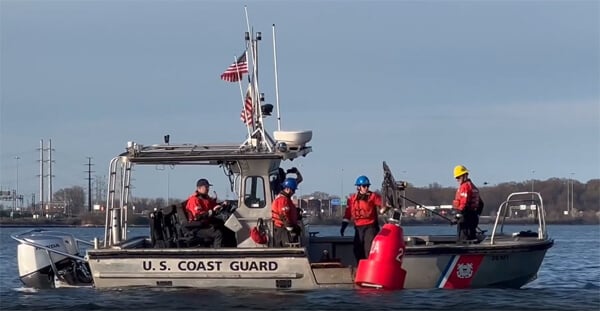
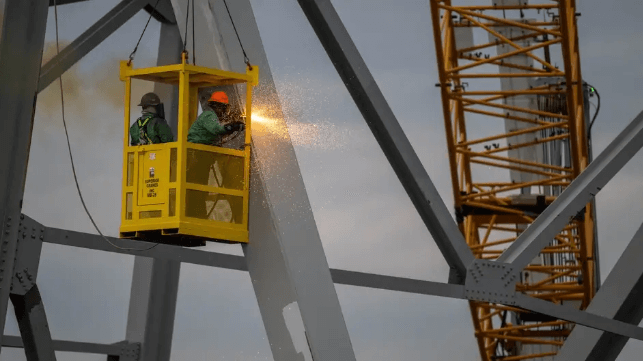
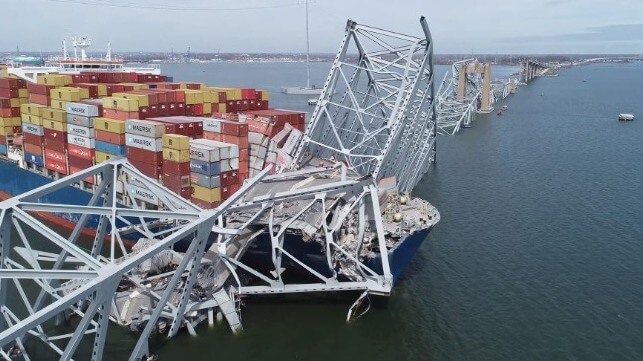
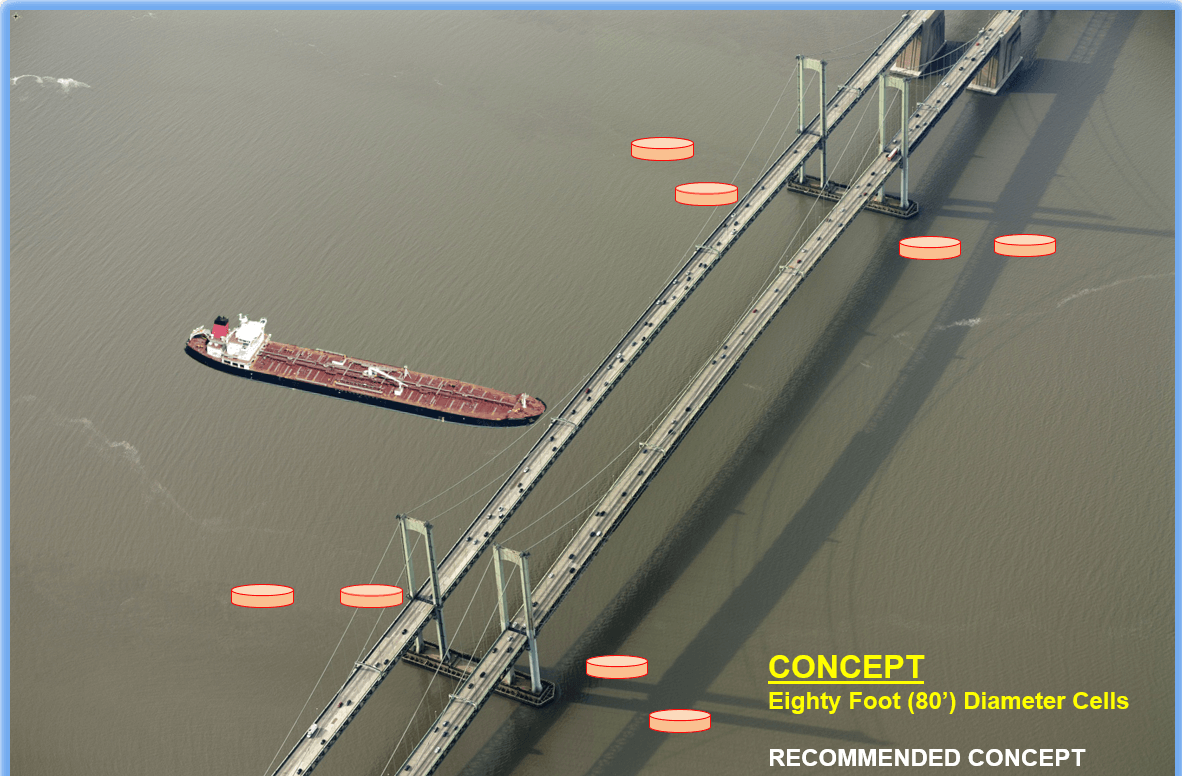 Illustration courtesy DRBA
Illustration courtesy DRBA